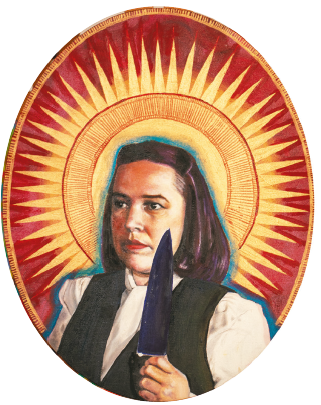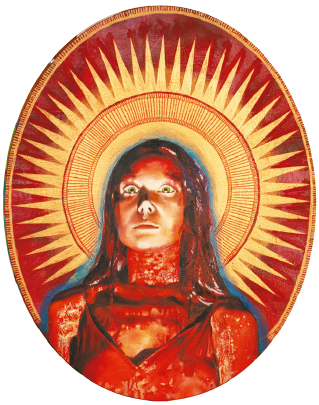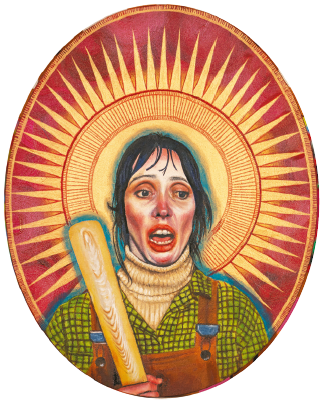Review: Critical Mass 12, Scream Queens and the Women Who Run with Wolves

“The Sentinels” by Ann-Beth Witherington
I walked through the exhibition Critical Mass 12 at Artspace – crowded with about 110 works, thoughtfully arranged in a salon-style hang by Director Ann Marie Gerhardt – much as I had driven the wildflower-laden highways from Dallas that afternoon: a bit disconnected and without real focus, letting things signal to me from the wall as they would.
Without much effort, most of the works quickly arranged themselves into categories: eyes and eyeballs; digital paintings made to look like actual paintings or real paintings made to look digital; landscapes: fishing scenes, farm scenes, open fields, and townscapes; paintings about Jesus, money, anger or peace; singers singing; colorful ‘hotel lobby’ abstraction; paintings of flowers; paintings of women or paintings of women and flowers; robot women; mothers; animals – dead or alive, real or imaginary.
Two works in the exhibition shared subjects in the Venn diagram of themes here, namely the ‘paintings of women’ and ‘paintings of animals,’ but because they were technically or conceptually more proficient, they did not fit tidily into these categories and these are the works that carried the show.
I was struck first by a dark, heavily veneered oil painting of a young girl looking down into a massive book that’s opened on her lap. The girl’s legs are crossed at the knees, rather than her ankles, a position which, though subtle, feels – as imagery of children goes – rather precocious. Her hair is thick and tossed over one of her shoulders, Rapunzel-like, her face not quite in focus, like a 70s magazine glamor shot. Her blue floral dress has innocently puffed sleeves but is short, revealing the aforementioned knees. How cute. Except, all around the child, emerging from the dark shadows behind the burgundy sofa on which the girl sits, comes snarling, menacing, furious dogs – a Doberman at her left with fully bared teeth and gums, a wolf lying on the floor under the arch of her crossed legs, staring out with narrowed eyes at the viewer, licking his lips. To her right, a small gray mutt, growling and crawling over the back of the sofa, another gray beast with his lower teeth thrust out in snarl, his paw flexed, claws digging into the soft plush of the couch near the puff-sleeved shoulder of the undisturbed young lady.
Part allegory, part joke, this painting by Anna-Beth Witherington, called The Sentinels, skewers the types of hazy, romantic portraiture of children and pets so often found above the family fireplace in American homes– paintings which, it turns out, Witherington makes a living painting. But she upends any notions of the sweet or the tame in this image, making the domestic animals into vicious protectors of the painting’s subject – the girl about to be a woman – asking them to antagonize the viewer.

“The Kings Unholy Trinity (Misery)” by Sarah Adams

“The Kings Unholy Trinity (Carrie)” by Sarah Adams

“The Kings Unholy Trinity (Wendy)” by Sarah Adams
In terms of the deep thinking that makes a work of art ring out, The Sentinels shows great conceptual promise for Witherington, so long she keeps siccing the dogs on people. And while her technical painting abilities need greater mastery (beware the trick of using shadows to hide a lack of anatomical modeling skill in the, um, shadows), this work indicates Witherington’s desire to be a better painter – to make difficult scenes with greater confidence and nuance.
The other work, which skewered, batted, and burned any polite categories and notions of ‘paintings of women’ and therefore made a mark, was the triptych of oil portraits by Sarah Adams, which took home the first-place prize for the exhibition. Called “King’s Unholy Trinity,” it’s a witchy little trio of female hero-villains from horror films adapted from Stephen King novels: Misery Chastain in “Misery,” Wendy in “The Shining,” and “Carrie” the titular character of that scream queen film.
While these ‘celebrity portraits’ could have been rife with cliches, Adams has chosen to paint the faces of these women on oval-shaped canvases, referencing both ancient religious icon painting and 18th-century portraiture. But here, rather than pictured holding some religious key, knitting or kitten, these women hold the tools of their crime or self-defense – a butcher knife for Misery, a bat for Wendy, and nothing but rage for Carrie, who’s covered in blood.
As with Witherington’s work, Adams has bravely embraced subject matter that could be deemed offensive or unbeautiful, and she’s done it with full-throttle conviction in a room where many other artists presented what they thought others would like to see. To boot, she’s an ace at painting, especially with the trickiness of skin tones, luminosity, and the implied psychology – effortlessly rendered here through facial expression and composition – of women taking matters into their own hands.
